Get Better Training and Buy-In for B2B Inbound Marketing
B2B Inbound marketing, while extremely effective, comes with challenges. Year after year, companies seem to struggle with the same efforts. While proving the ROI of marketing activities is still the top challenge, finding an executive sponsor and team training are rapidly rising to the top of the list. Companies need both executive buy-in and appropriate training of sales and marketing teams to achieve the inbound marketing success they strive for. While all other challenges mentioned in this survey have declined from the previous year, these two have increased. HubSpot’s “State of Inbound 2015” report examines these developing trends.
The statistics speak for themselves: compared to 2014, finding an executive sponsor is 7 times more likely to be considered a challenge in 2015. Similarly, training one’s team was twice as likely to be listed as a challenge in 2015 than in the previous year. In order to understand the importance of these two trends, let’s break them down.
Executive Sponsorship
The aforementioned statistic on executive sponsorship speaks to the struggles that marketers are having. In 2014, only 2% of companies named executive buy-in as a top marketing challenge. In 2015, 14% did. This stark increase means that companies who have made the switch to inbound marketing are finding it harder to get executives to buy-in to the efforts and best practices that come along with it. Without buy-in, companies will struggle to see the positive impacts inbound has to offer. With tight budgets, executives are hesitant to sponsor. But, once they see how critical inbound is to marketing success, they are more likely to hop on board. But what and how do they need to see in regards to inbound?
The Long Game
What they need to primarily understand is that inbound marketing is a long game. It takes time to implement—even for companies that have the proper infrastructure in place—let alone roll out and ramp up to see gains. A blog from Lean Labs speaks to this, and offers these numbers:
- 6 to 8 months: you should see positive movement compounding each month
- 12 months to 24 months: you should see substantial growth of traffic. As well as MQL-SQL-customer acquisition
Content Marketing Basics
There are some basics that need to be in place for content to translate into money. For your content to grow, you need to ensure a few things to help it along:
- A plan
- Quality
- Frequency
- Promotion
Plan: As with anything, persistence, consistency, and proper implementation will impact its ultimate success. The first element to have in place is to create a strategy; a plan. Whether you do your marketing in-house or work in partnership with a marketing agency, a sales-centric content marketing strategy needs to exist within a defined structure.
Quality: What’s the basic infrastructure consist of? Topping the list is a website with quality content that is robust, relevant, and contemporary. Your litmus test for its efficacy should be that your website can answer prospect and customer questions—to a reasonable degree—after business hours or when you can’t readily be available. People should be able to find your website based on keywords that they search for.
Speaking of keywords—now we’re getting to the meat of inbound: robust, relevant content. You need people to write quality content. Yes, you want competent marketing writers on staff (or retainer), but you also have a deep well of resources under your roof in every department. Your employees are your most valuable resource. At Grant Marketing, we run workshops with companies to help them understand all these factors and to tap into their goldmine of expertise to help create a content marketing culture. That’s another blog, entirely, but for our purposes here, know that there are many ways to extract the valuable insights your teams hold and turn that knowledge into the kind of info that prospects and customers want to find (at their convenience). Yes, we’ve heard the dissenting, “But I’m not a writer!” cries from the masses. That’s what a seasoned marketing team helps elicit and curate. Whether they help edit content to bring it to a polished, publishable piece, or conduct interviews with your staff to get the information they need to write the blogs—the vital info is all readily at hand, just waiting to be used as an insightful blog, informative white paper, persuasive case study, or easy-to-ingest infographic.
Once that is solid, you should have a web developer on hand who can ensure that your website is “responsive” (mobile friendly). No secret that mobile usage continues to rise, and Google has placed top-ranking importance in its latest algorithm on a company’s mobile readiness. SEO is still a vital consideration, but keywords aren’t the only factors, as this mobile-specific requirement makes clear.
Frequency: HubSpot tells us, “B2B companies that blogged 11+ times per month had almost 3X more traffic than those blogging 0 - 1 times per month.” The results can vary with the consistency. A Spinweb blog graphs the results of a manufacturing company that saw a 2x increase in website traffic over a 24 month period—they blogged “about” once per week and generated content at a “fairly slow pace.” Compared to a software company that was a bit more aggressive in their content marketing activities—they had a dramatic increase in website traffic: up to 14x or 1400%. How’d they do this? By investing in an inbound marketing program that included “weekly blogging and a more aggressive content generation schedule. They have offers going out every other month at minimum and as a result they are seeing faster results that are much more dramatic.”
Promotion: Your quality content isn’t worth much—to you or your prospects and customers—if nobody reads it. Keywords and SEO ranking take time to build up, so it’s on you to promote your content to help it build up steam. Your most effective platforms for promoting your content are through emails and social media. Trust in the relevant content to continue the conversation with prospects and customers, and hope that they’ll be impressed enough to share that with their colleagues. Lean Labs has a great primer guide that will help you get a broader sense of how to use the four most popular social media platforms: Facebook, LinkedIn, Twitter, and Google+. Remember to “speak” in the language of each platform, and that these are not one-way conversations with people. Social media offers responsive, dynamic opportunities to spread brand awareness, create brand enthusiasts—and damage it, too. The latter is not reason to hesitate to use social media—more an incentive to use it to its fullest.
Team Training
So your company has adopted inbound marketing … now what? Providing your sales and marketing teams with valuable training is the most important next step. Only 6% of companies listed team training as a marketing challenge in 2014, compared to the 12% of companies in 2015. It is crucial that your team is trained and well versed in the inbound specifics, as this is what will earn you the best results.
How should you be training your employees? Teach them how to make the most of content marketing. Stress the importance of creating content that customers find relevant, educational, and informational. One of the fundamental training issues marketing/sales teams (yes, they should be integrated to some degree to work as a team!) is that there is a disconnect between the intel marketing provides and the ability of the sales team to interpret and work with that data. This includes gathering analytics regarding leads, website visits, content downloads, etc. It’s all relatively new, so it’s understandable that this gap exists.
CRM Is Critical
Also, teach team members the fundamentals of sales CRM. Great news: according to LinkedIn, CRM offers an average return of $5.60 to every $1 spent. Bad news: the same article states that about 24% of companies are not utilizing CRM. Also, in the 76% of companies who do implement CRM, between 25 and 60% of projects fail to meet expectations. It’s time your company puts CRM first to maintain the critically important relationships you have established with customers. As mentioned above, it is important that your team knows how to analyze your inbound strategies—this way, you know what you excel at or need to improve.
In the end, the C-Suite wants to see ROI results and real numbers to back it up. Research from HubSpot shows that inbound marketing produces 54% more leads than traditional marketing and saves $20,000 on average per year by investing in inbound as opposed to traditional marketing. Those numbers sound good to us.
If your business has already implemented inbound marketing, but you are not yet seeing the results you want, you are not alone. Here at our Boston-based B2B marketing company, Grant Marketing, we can help you solidify your inbound strategy or run a Content Marketing Workshop for you.
For further reading on the trends discussed and more, download HubSpot’s “State of Inbound 2015” here.
Many thanks to freelancer, Samantha Hunter, for her contributions to this blog.



